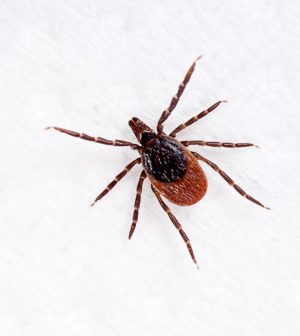- Navigating Your Midlife Crisis: Embracing New Possibilities
- City Raccoons Showing Signs of Domestication
- Mapping the Exposome: Science Broadens Focus to Environmental Disease Triggers
- One Week Less on Social Media Linked to Better Mental Health
- Your Brain Changes in Stages as You Age, Study Finds
- Some Suicide Victims Show No Typical Warning Signs, Study Finds
- ByHeart Formula Faces Lawsuits After Babies Sickened With Botulism
- Switch to Vegan Diet Could Cut Your Greenhouse Gas Emissions in Half
- Regular Bedtime Does Wonders for Blood Pressure
- Dining Alone Could Mean Worse Nutrition for Seniors
Everything You Need to Know About Lyme Disease

With growing concern about mosquito-borne viruses such as Zika, it’s easy to let down your guard when it comes to ticks. But Lyme disease is still a danger, especially in the Northeast and upper Midwest. In fact, it has affected people in almost every state.
Lyme disease is spread through the bite of an infected tick. Ticks can attach anywhere on the body, often in hard-to-see areas like groin folds and underarms. Checking for ticks after every walk in wooded and grassy areas helps, but most people are infected by immature ticks, less than 2 millimeters in size and very hard to see.
Immature ticks feed during the spring and summer months. Adult ticks are most active during cooler months of the year. They’re larger and easier to spot and remove before they’ve had time to infect you. In most cases, a tick must be attached for 36 to 48 hours to transmit the disease.
Since it’s not always possible to spot an attached tick, be aware of common Lyme symptoms and see your doctor right away if you suspect infection. Untreated, Lyme disease can progress to severe arthritis and neurological problems.
Signs and Symptoms
- 3 to 30 days after a bite: An expanding rash, starting at the bite site, that often looks look like a big red bullseye; flu-like fever, chills, headache, fatigue and body aches; as well as swollen lymph nodes.
- Days to months after a bite: Severe headaches and neck stiffness; additional rashes; arthritis with severe joint pain and swelling; heart palpitations, dizziness or shortness of breath; shooting pains, numbness or tingling in the hands or feet.
Antibiotics can usually cure Lyme. If you discovered the tick early on, you may be a candidate for preventive treatment with a single dose of doxycycline before any symptoms appear.
Preventive treatment is possible in counties or states where Lyme disease is common, provided the tick is properly identified (save to show to the doctor) and was attached for less than 36 hours, often based on how engorged it was when you found it. Treatment can be started within 72 hours of tick removal — provided you aren’t pregnant, breastfeeding or allergic to the medication.
Of course, preventing a bite is the best protection. Tests done by Consumer Reports found that many insect repellents with DEET or picaridin are effective. Of the so-called natural agents like lemon oil and eucalyptus, only the Repel brand worked well. To sidestep ticks, walk in the sun — ticks like shady areas with hiding places like tall grasses and leaf piles. Wear light-colored clothes and long pants and long sleeves. Tuck your shirt into your pants and your pants into your socks.
Ticks can spread many dangerous diseases besides Lyme so it’s important for you, your children and your pets to avoid them.
More information
The U.S. Centers for Disease Control and Prevention has more on Lyme disease and other tick-borne illnesses.
Source: HealthDay
Copyright © 2025 HealthDay. All rights reserved.










